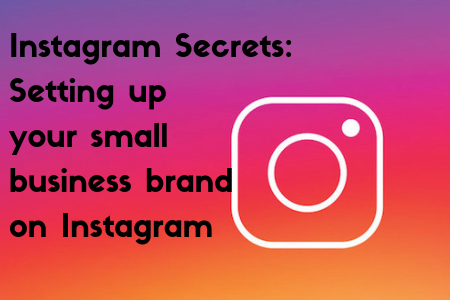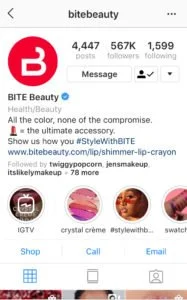Instagram Secrets: Setting up your small business brand on Instagram
If used correctly, Instagram can be a powerful tool for small business owners wanting to attract new consumers. It can also help you to build brand awareness and loyalty, but where do you start? Today, we’re covering how to build your small business brand on Instagram.
#1: STRATEGY & RESEARCH
As with all strategies, it’s important to first determine who your target audience is and what you want to gain from your presence on Instagram. Once you have that, you can begin to tackle style and content. A helpful tip is to think of both your audience and your competitors – who is your direct competitor and who is following them? By researching your competitors, you can begin to discover what works for them and what type of content your audience is already searching for and engaging with.
#2: WRITING YOUR INSTAGRAM BIO
The bio section is the perfect spot to say who you are and what you do in a short and sweet way! With that in mind, your Instagram bio should be short and concise.
A great bio will include the basics, the business name, services or a description (I.e. what you provide, your Unique Selling Point), and a link to your website. You can also use additional info to elevate your bio. The addition of hashtags, for example, can have multiple benefits. If you have a branded hashtag, you can use it in your bio to collect and link to user generated content. Using branded and targeted generic hashtags in your bio also makes your business more searchable and allows the opportunity for more engagement.
Instagram only allows for one shared link and you should take full advantage of it! The last line of your bio is a great place to leave a Call-to-Action. For example, if you have an event or a sale coming up, invite your audience to buy tickets or shop the sale through clicking the link below it.
Don’t forget to include a phone number, an email and your location so that you’re more accessible to your audience. And you can add these buttons easily if you have your profile set up as a business profile.
Bonus Bio Content: Highlights
BITEBeauty
Instagram Highlights are a great tool to utilize provided that your business has the content for it. Highlights are groupings of your Instagram Stories and can be grouped into categories. A fashion brand, for example, may have highlight sections for new arrivals, customers wearing their styles, events, styling tips, and more.
Here is an example of a great Instagram bio from the brand BITE Beauty. They’ve included their name (BITE Beauty), their sector (Health/Beauty), a short description of what they do (“All the color, none of the compromise. 💄= the ultimate accessory.) They’ve also included a Call-to-which includes a branded hashtag (Show us how you #StyleWithBITE) and they’ve included a link to their recent cosmetic release as well as the options to Shop, Call or Email them.
#3: STYLE
Once you have an idea of what resonates with your audience, you can begin to define your style. Style should be consistent and should be a good representation of your brand personality. For example, in one of our previous blogs, we shared the Instagram page for Kate Spade, which utilizes shapes, patterns, and bright colours to portray the fun, daring, and chic persona of the brand. Here are two things to consider:
Tone & Voice – First you’ll want to think about your brand tone or voice, you’ll want this to be natural and in line with your brand. Is your brand playful? Cool? Tongue in cheek? Flirty? Think of words that would describe your brand and let that help guide your tone and voice.
Look & Feel – With style also comes the look and feel of your Instagram feed. You’ll want this to also be in line with your tone and voice. Consistency is key. For example, Toronto indie clothing brand Hayley Elsaesser is known for their fun, eye-catching prints. Their Instagram utilizes a lot of bold colours in the imagery and cute emojis in their captions. These touches help to capture the essence of the brand.
It may seem obvious, but it’s important to consider your image quality and style. If your business sells products, you can do studio images that range from simple product shots, to lifestyle shots, and everything in between. If you researched your competitors, this may give you an idea of the type of look and images that attract your target audience.
You can also create a theme for your Instagram feed to help with consistency and overall look. Themes may be specific to filter and colour usage or format. An example of a theme would be colour splash, this entails a limited colour story within the imagery but with splashes of bright colours, for example 1 of 6 photos may use a bright and bold colour.
For a small or independent business with minimal resources, you may be hesitant to hire a photographer. Luckily, you can capture some beautiful shots with the right lighting, a good camera (even if it’s your phone), and with the help of apps such as Snapseed , if needed. Once you feel comfortable and gain traction on the platform, you can decide how much you want to invest in it. For example, you could invest in more professional images and videos, sponsored posts, etc.
#4: CONTENT
So, you know your audience and your style, what’s next? Start creating that content! Take photos, create captions and begin planning! Apps and websites like Hootsuite (allow you to plan your content ahead of time. This allows you the ability to plan ahead and gives you an overview of what your Instagram feed will look like!
#5: TRACK
You’ve started posting, what’s next?
With an Instagram business profile, you can use the platform’s built in insights to discover how your posts are performing and your audience engagement. Through Instagram Insights you can see how your account is performing in three main categories: Activity, Content and Audience. The “Activity” section shows you stats such as the number of visits you’ve received for the week. The “Content” section accounts for stats related to your content – for example, you can see how many times a recent post has been viewed. Lastly, the “Audience” section gives you insights about those who are following you and viewing your content, this could include their location, age range, and gender.
With these insights, you can track and record results weekly to determine what’s resonating with your audience so that you can tweak and optimize your Instagram strategy.
A REMINDER ABOUT GROWTH
Here is a reminder of a few things we have discussed before about growing your Instagram following:
Hashtags – #Hashtags are words that are relevant to your business. If, for example, you’re a local fashion boutique, some relevant hashtags may be #fashion, #shoplocal, #fashionista, etc.
Stories – Stories are Instagram posts that last 24hrs. They’re generally fun and even impulsive and are often used to post stuff that you don’t want to keep as a post on your main feed. For example, if your boutique has an event, you may use Instagram stories throughout the event but, use the Instagram feed to show only highlights from the event, if at all.
Engage – Instagram is social media, so don’t forget to engage with others! Liking and replying to comments as well as commenting on others posts helps create a connection and fosters interest as well as loyalty.
For more information check out more of our blog posts here or our Social Media Starter Kit here!


